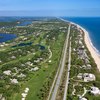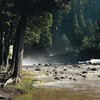The Florida peninsula is made of up four main land regions: the coastal plains, the uplands, the Everglades and the Florida Keys. Found across these regions are a variety of water features, including marshes, springs, swamps, lakes, rivers and ponds. Although much of the face of Florida has been altered by development, a substantial amount of the original topography remains preserved as state and national parks.
Coastal Plains
Florida's coastal plains stretch inland from the ocean on the state's Atlantic and Gulf coasts. The plains consist of flat land fronted by barrier islands, sandy beaches, sand bars and coral reefs. Dunes are also a characteristic of the coastal plains. Dunes are formed as the wind carries sediment inland from the beach, forming large linear accumulations of sand. The dunes on Florida's west coast tend to be short, and dunes in the Panhandle region of northern Florida tend to be taller.
Uplands
The uplands are the hilly areas of northern Florida, as well as the raised spine that runs down the center of the state, which is the site of most of the state's citrus production. Florida's highest elevations are in the Panhandle, with Britton Hill the highest point at 345 feet. The uplands consist of several ecosystems, including pine flat woods, scrub and high pine and temperate hardwood forests. The majority of the uplands consist of pine flat woods, which evolved under frequent lightning-caused and human-caused fires.
Everglades
The Florida Everglades, an immense swamp about eight feet above sea level, is the largest subtropical wilderness in the United States. Much of the area, which is dotted with bays, channels, lakes and islands, is protected as Everglades National Park, which was established in 1947. The Everglades covers 4,300 square miles, and water moves across the area at a slow pace from Lake Okeechobee to the Gulf of Mexico and Florida Bay. The mild climate of the area provides an ideal habitat for birds, alligators, turtles and snakes. The Everglades has been designated an International Biosphere Reserve and a World Heritage Site.
The Florida Keys
The Florida Keys consist of 1,700 islands that form an archipelago running from the southeastern tip of the Florida peninsula to the Dry Tortugas in the Gulf of Mexico, home of Dry Tortugas National Park. Although the majority of the islands are uninhabited, some are popular vacation destinations, including Key West and Key Largo. Because the keys are made of rock, they have few sandy beaches. The Florida Keys are home to the only living coral reef in the continental United States.
References
Photo Credits
- Jupiterimages/Photos.com/Getty Images




